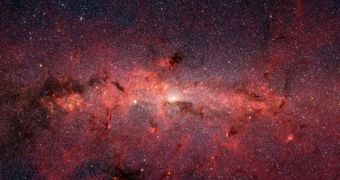Following the latest research results, astronomers concluded, during the 213th meeting of the American Astronomical Society, that our galaxy, the Milky Way, is about 50 percent heavier than previously thought, and that the speed with which it spins is also much greater than first calculated. The scientists came to this conclusion by analyzing the distance between our solar system and the core of our galaxy, which is estimated at about 28,000 light-years. They deduced that the mass was heavier than first thought from the fact that the turning speed was faster.
According to their estimates, our galaxy, as a whole, spins 600,000 mph (970,000 kph) to 100,000 mph (160,000 kph) faster. This translates into a 50 percent increase in mass. This means that our galaxy is comparable to Andromeda in most aspects and is not the giant galaxy's smaller sister. Harvard-Smithsonian Center for Astrophysics researcher, Mark Reid, who was part of the team that made the find, says that the new mass for our galaxy is about 3 trillion solar masses, which means that the gravitational pull our corner of the Universe exerts on nearby objects is greater than estimated before.
This is also bad news for us, in a way, because the larger the pull, the bigger the chances of our galaxy attracting smaller nearby ones, or colliding with them. Of course, there is nothing to fear in the near future, because these events usually take billions of years to happen, but astronomers have already begun revising their estimates of how galaxies in our Local Group family interact with each other.
Also, the new discovery means that our galaxy most likely has four spiral arms from which stars and planets are born, and not just two, as previously believed. "Most star-forming regions do not follow a circular path as they orbit the galaxy; instead we find them moving more slowly than other regions and on elliptical, not circular, orbits," Reid explains.
The National Science Foundation's Very Long Baseline Array (VLBA) radio telescope was used for these measurements. The device mapped various regions of our galaxy, calculating distances from one celestial object to another, as well as relative motion of many of these objects. The array of radio-telescopes used for this task stretches from the Caribbean to New England, and has the capacity to observe forming stars in each of the two arms of our Milky Way that are known up to this point.

 14 DAY TRIAL //
14 DAY TRIAL //